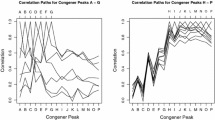Abstract
A common statistical problem is deciding which of two possible sources, A and B, of a contaminant is most likely the actual source. The situation considered here, based on an actual problem of polychlorinated biphenyl contamination discussed below, is one in which the data strongly supports the hypothesis that source A is responsible. The problem approach here is twofold: One, accurately estimating this extreme probability. Two, since the statistics involved will be used in a legal setting, estimating the extreme probability in such a way as to be as generous as is possible toward the defendant’s claim that the other site B could be responsible; thereby leaving little room for argument when this assertion is shown to be highly unlikely. The statistical testing for this problem is modeled by random variables {X i } and the corresponding sample mean \({\bar{X}} = \frac{1}{n}S_{n},\;S_{n} = {\sum\nolimits_{1}^{n} {X_{i}}},\) the problem considered is providing a bound ɛ for which \(\hbox{Prob} \left({\bar{X}} \geq a_{0} \right) \leq \varepsilon,\) for a given number a 0. Under the hypothesis that the random variables {X i } satisfy E(X i ) ≤ μ, for some 0 < μ < 1, statistical tests are given, described as “generous”, because ɛ is maximized. The intent is to be able to reject the hypothesis that a 0 is a value of the sample mean while eliminating any possible objections to the model distributions chosen for the {X i } by choosing those distributions which maximize the value of ɛ for the test used.
Similar content being viewed by others
References
Abramowitz M, Stegun I (1965) Handbook of Mathematical Functions, National Bureau of Standards. Applied Math Series 55, US Government Printing Office, Washington
Dacunha-Castelle D, Duflo M (1986) Probability and statistics I. Springer, New York
Dacunha-Castelle D, Duflo M (1986) Probability and statistics II. Springer, New York
Ross S (2003) Introduction to orobability models. 8th edn. Academic, Boston
Schwartz A, Weiss A (1996) Large deviations for performance analysis. Chapman and Hall, London
Author information
Authors and Affiliations
Corresponding author
Rights and permissions
About this article
Cite this article
Hromadka, T.V., Whitley, R.J., Horton, S.B. et al. Generous statistical tests. Stoch Environ Res Risk Assess 23, 9–12 (2009). https://doi.org/10.1007/s00477-007-0190-6
Published:
Issue Date:
DOI: https://doi.org/10.1007/s00477-007-0190-6




